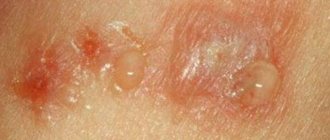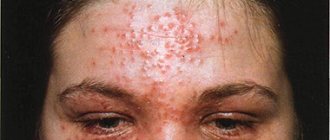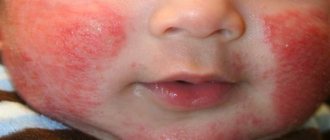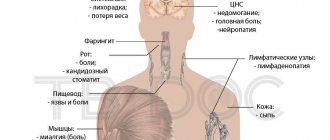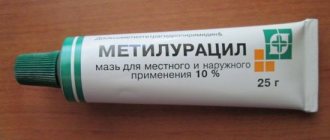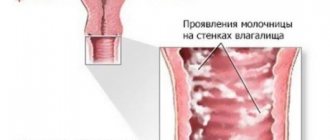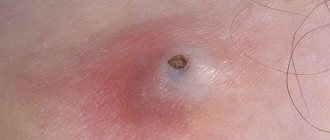About dermatitis Symptoms Types of dermatitis Treatment of dermatitis
Dermatological skin diseases belong to the category of pathologies, often causing both physical and psychological discomfort. Complications that develop if treatment is delayed can lead not only to physical discomfort, but also to the development of social phobia. Atypical dermatitis is no exception. Although this disease mainly affects children, cases of pathology in adults also occur.
The article provides information about the causes of atypical dermatitis, the clinical picture of the disease, and also describes the factors contributing to the development of the pathology. In addition, you can find out which methods are the most effective for dermatitis and which remedies help to minimize the symptoms of the disease and achieve significant remission.
Stages of atopic dermatitis
Atopic dermatitis is characterized by the presence of two stages:
Acute stage. It is expressed by severe redness of the skin, itching, dryness, swelling, the appearance of wounds and blisters.
Chronic stage - the spots take on clear outlines, the skin thickens, and cracks may appear. The itching becomes very severe.
Scratching the inflamed areas can lead to the appearance of pustular rashes due to dirt getting into the wounds.
Drug therapy
During an exacerbation, you can get rid of atopic dermatitis, or rather its clinical manifestations, by taking a number of medications.
Let's look at them in more detail.
Antihistamines
Thanks to their basic properties, they can reduce the severity of such manifestations of the disease as itching of the affected areas of the skin, redness and swelling in this area.
The most popular among them are:
- Tavegil. The long-acting drug can be prescribed to children over one year of age. You should not increase its dosage on your own, as this can lead to disorders of the digestive and nervous systems.
- Suprastin. It also has the above-mentioned effect on the body, but is used less frequently, which is associated with a large number of contraindications (in particular, children under 6 years of age) and side effects.
Diphenhydramine or Pipolfen are used only after consulting a doctor.
On average, taking this group of drugs lasts about 10 days, but in some cases it can take 3 months.
Anti-inflammatory drugs
They are practically not used for children under 14 years of age due to the high risk of developing dangerous complications.
This list includes tablets Ortofen and Indomethacin, as well as Butadione in ointment form.
Corticosteroid ointments and creams
Highly effective drugs in the treatment of acute atopic dermatitis. They are appointed for a short period of time. They are used only in complex therapy, which consists of taking anti-inflammatory and keratolytic drugs.
Many drugs from this group are not used to treat children, but there are exceptions, for example, drugs with local action - Celestoderm and Fluorocort, which are allowed for use from one year of age. You should stop taking them gradually.
Elidel drug
A new drug, a derivative of pimecrolimus. Serves as an excellent alternative to corticosteroid drugs. This is due to the combination of high efficiency and safety, thanks to which this product can easily be used in children from six months of age.
A group of people who have already been treated with this drug note its effectiveness.
Combination drugs
Complex therapy may include: Triderm cream, Pimafucort based on antibiotics, glucocorticosteroids and antifungal agents. They are used if an infectious process is associated with atopic dermatitis.
Cleansing the body
Another important point is detoxification therapy. For this purpose, enterosorbents (Enterosgel, Filtrum) are used for 14 days or Reopoliglucin.
You should not use any of these medications on your own; only your doctor can select the correct dosage and determine the required duration of use.
Phases of disease development
There are three phases of pathology development:
- infant;
- children's;
- adult.
The first two phases last until the age of 14-17 years, when hormonal levels change. The scalp, arms, legs, buttocks become inflamed.
After puberty, in the adult phase, atopic dermatitis is characterized by the formation of red spots under the knees, in the elbows, and on the neck-collar area. To have a clearer picture, you can study various photos of atopic dermatitis.
Possible complications
Atopic dermatitis can contribute to the development of other allergic diseases, in particular asthma. But it is the skin that suffers the most. Due to constant scratching, the dermis is injured and loses its ability to resist various infections, ulcers and scabs appear.
Often there is a high temperature and poor health of the patient. The herpes virus can trigger the development of infectious skin diseases.
Against the background of atopic dermatitis, the fungus causes an infection in infants, and thrush appears in the oral cavity.
Symptoms
Among the first and main signs of the development of drug-induced dermatitis are:
- peeling;
- swelling;
- redness of the affected area;
- blisters and rashes on the skin;
- burning and pain in the area of skin inflammation.
On this topic
- Dermatitis
Effective methods for treating perioral dermatitis on the face
- Inna Viktorovna Zhikhoreva
- September 25, 2020
In more severe cases, the following disorders are observed:
- deterioration of nutrient between tissues and the environment;
- excessive dryness of the epithelium;
- or, conversely, increased fluid secretion.
Pathology in its development has two types:
- fixed;
- contact.
The first form of the disease is manifested by inflammation of the skin and its color in a shade of brown. In addition, blisters, acne and erosions form at the site of the lesion. If the drug is used for a long time, hyperpigmentation appears, affecting various areas of the body.
Inflammatory processes in most cases are observed on the face and neck, sometimes spreading to other areas of the skin.
The contact form of dermatitis can be triggered by medications that are used externally. In this case, the pathology will appear only at the site of application of the gel or cream. This type is characterized by symptoms such as:
- pain;
- burning;
- itching;
- inflammation;
- blistering and folliculitis .
Also, cracks may form at the site of application of the drug, which cause the formation of erythema.
Treatment
It is not worth treating atopic dermatitis on your own; it is better to trust dermatologists and allergists. When prescribing treatment for atopic dermatitis, the severity of the disease and the age of the patient must be taken into account.
First, you should neutralize the irritating factor that caused the exacerbation of the disease. Then help the body reduce its reaction to the allergen, relieve inflammation and itching, and treat associated diseases and complications. The final stage is the prevention of re-exacerbation.
Preventive measures
Prevention of the disease will help to avoid atopic dermatitis and not think about its treatment in both children and adults.
Primary prevention of dermatitis is recommended to begin before the birth of the child. Various factors influence the developing fetus and mother:
- medicines;
- toxicosis;
- food;
- chemical substances.
But even after birth it is important to be careful. In infants, the immune system is still very weak, immunity is just developing.
Breastfeeding is preferable for a newborn, so a nursing mother should carefully monitor her diet and her health. It is advisable to minimize the mother’s intake of medications.
Secondary prevention is aimed at preventing the progression of dermatitis in the acute phase, easing the progression of other chronic diseases, and reducing the possibility of triggering the manifestation of atopic dermatitis. Following a special diet and relaxing on the seaside will help avoid relapses.
For preventive purposes, the quality of daily skin care is important. The skin must be cleansed delicately to avoid unintentional injury, moisturized, protected from aggressive environments, and nourished.
Relapses can recur every few years, or they can flow from one to another.
For people with such problems, it is extremely important to choose the right profession in order to protect themselves as much as possible from interaction with unfavorable factors.
Measures to prevent the disease
To avoid the manifestations of atopic dermatitis, you should adhere to the following rules:
- protect yourself from communication with pets (cats, dogs, reptiles, birds);
- stick to the regime, set aside enough time for proper rest;
- follow the recommendations of a dermatologist, allergist and nutritionist;
- follow a diet;
- quit smoking and alcohol;
- get rid of dust accumulations.
Remember, when the first signs of pathology appear, you should immediately consult a doctor. The course of therapy is based on the use of drugs and traditional medicine; alternative methods of treatment are used as additional ones. Timely intervention helps to minimize the symptoms of the pathology and get rid of it forever.
